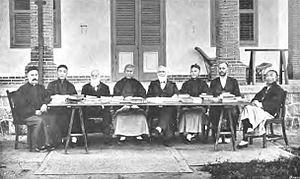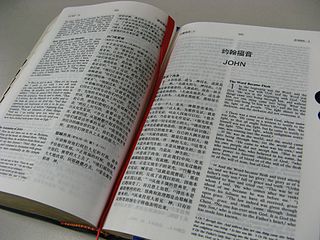- Chinese Union Version
-
Chinese Union Version Full name: Chinese Union Version Other names: 和合本 Abbreviation: CUV Language: Chinese OT published: 1919 NT published: 1906 Complete Bible published: 1919 Author(s): C.W. Mateer et al. Derived from: English Revised Version Publisher: China Christian Council or Hong Kong Bible Society (current) Copyright status: Public domain (copyright expired) Religious affiliation: Protestant Genesis 1:1-3起初,神创造天地。地是空虚混沌,渊面黑暗;神的灵运行在水面上。神说:“要有光”,就有了光。
Genesis 1:1 in other translations神爱世人,甚至将他的独生子赐给他们,叫一切信他的,不至灭亡,反得永生。
John 3:16 in other translationsThe Chinese Union Version (CUV) (Chinese: 和合本; pinyin: héhé běn; literally "harmonized/united version") is the predominant Chinese language translation of the Bible used by Chinese Protestants. It is considered by many[who?] to be the Chinese Protestant’s Bible.
The CUV was translated by a panel with members from many different Protestant denominations, using the English Revised Version as a basis and original manuscripts for crosschecking.[citation needed] Work on the CUV began in 1890 and originally, three versions of the CUV were planned—two classical Chinese versions and a vernacular Mandarin version. The CUV was completed in 1919, with one amalgamated classical Chinese translation and one vernacular Mandarin translation. With the onset of May Fourth Movement, and the associated New Culture Movement, the CUV is the first translated work to be published in Vernacular Chinese[citation needed].
The CUV in use today is the vernacular Mandarin version, published in two slightly different editions—the Shen Edition (神版) and the Shangti Edition (上帝版)--differing in the way the word “God” is translated.
The vernacular Chinese language has changed a lot since 1919. Indeed, CUV’s language sounds stilted to modern readers. Furthermore, a lot of Chinese characters used in the CUV have fallen into disuse and cannot be found in commonly-available dictionaries today. As a result, work is underway to modernize the CUV.
The CUV is published in Hong Kong by the Hong Kong Bible Society, a bible society affiliated with the United Bible Societies, in Taiwan by the Bible Society in Taiwan, also associated with the United Bible Societies, and in mainland China by Amity Printing Co., Ltd., of the Amity Foundation in Nanjing, related to the China Christian Council and also affiliated with the United Bible Societies. However, the text of the CUV has fallen into the public domain.
The CUV is currently available in both traditional and simplified Chinese.
Contents
Typography of the Chinese Union Version
 Frederick W. Baller, C. Goodrich, Calvin Wilson Mateer, Spencer Lewis, and George Sydney Owen each with expert Chinese language assistants
Frederick W. Baller, C. Goodrich, Calvin Wilson Mateer, Spencer Lewis, and George Sydney Owen each with expert Chinese language assistants
Text in the Chinese Union Version is typeset generally vertically from right to left, with some captions for illustrations typeset horizontally from left to right. The typography is unusual, with many archaisms and some ad-hoc typographic devices.
The CUV employs old-style punctuation, setting most punctuation marks as if they were ruby. It uses the standard proper name mark only for personal names, but an ad-hoc punctuation mark that can be described as a “double proper name mark” is used for geographical names; both of these are typeset on the right-hand side, instead of the currently-standard left. The book title mark is not used, and book titles are not marked in the CUV in any way. Chapter and section headings are typeset in sans serif type.
Verse numbers are typeset on the right-hand side of the first word of each verse as ruby. They are also repeated in the margins.
New paragraphs start after chapter and section headings. Within each section, however, paragraph breaks are indicated by the traditional Chinese pilcrow, a thin, sans-serif circle about the size of a Chinese character.
In the Shen Edition of the CUV, a full-width space is added before each word “God” so that the paging between the Shen and Shangti editions are identical; this extra space is interpreted as the traditional honorific marker.
Comments and notes are typeset as warichu. Additionally, an ad-hoc punctuation mark that looks like a dashed underline is used to mark editorially-inserted words; like the two varieties of the proper name mark, this mark is also typeset on the right-hand side.
Typesetting the proper name mark on the right would have caused clashes with verse numbers and most punctuation marks. However, when clashes occur, the proper name and similar punctuation marks that cause the clash are partially truncated to avoid omitting any punctuation marks.
Derivatives of the Chinese Union Version
The English-Chinese Bible: New Revised Standard Version and Chinese Union Version with simplified Chinese characters (printed by Amity Printing Company and published by China Christian Council)
Chinese Union Version with New Punctuation
Because of the old-style and ad-hoc punctuation used, the punctuation of the CUV thus looks both archaic and somewhat strange to the modern reader. The result of updating the CUV’s punctuation in line with modern usage is the Chinese Union Version with New Punctuation (CUVNP, Chinese: 新標點和合本 or Chinese: 新标点和合本}, pinyin: xīn-biāodiǎn héhé-běn). Work on the CUVNP has been completed and the CUVNP has already been published.
This version with the Chinese characters written horizontally, printed by Amity Printing Company, Nanjing, and published by China Christian Council, Shanghai, constitutes the largest majority of the Bibles available in the present-day China. Some wordings and proper nouns (people's names and place names) have been changed from the original 1919 version, in order to adapt to the modern use of the Chinese language. which is clearly noted in the preface and addendum. A smaller number of copies of a bilingual Chinese-English edition, the Chinese Union Version combined with the New Revised Standard Version, is also published by China Christian Council.
Revised Chinese Union Version
On 2010, work on the Revised Chinese Union Version (RCUV) (和合本修訂版, pinyin: héhé-běn xiūdìng-bǎn) has been completed to update the language of the CUV while keeping the original CUV translation as intact as possible. The revision to the New Testament was completed in 2006, and to the entire Bible in 2010. This version was consecrated on 27 September 2010.
Other derivatives
After the text of the CUV had fallen into public domain, publishers began publishing slight variations of the CUV without identifying that these are different versions.
Online versions
The CUV is readily available online, due to its public domain status. The text in the online versions, however, is slightly different because Big5 does not contain all the characters needed to typeset the CUV. The SWORD Project has free modules for the Union Version. It is also available for free reading on their online Bible Study website.
Protestant Worship in China
The Chinese Union Version of the Bible, the Chinese New Hymnal, the Lord's Prayer as it is written in the Chinese Union Version and the Apostles' Creed (not the Nicene Creed) are usually used in the Protestant worship in the present-day China.
References
- Hong Kong Bible Society — official publisher of the CUV; detailed history of the CUV can be found there
- « 聖經 : 香港聖經公會印發 » (The Holy Bible : Printed and published by the Hong Kong Bible Society)
- « 圣经 : 中国基督教协会(南京)出版发行 » (The Holy Bible : Printed and published by the China Christian Council)
- China Christian Council, the organization which also act as the official publisher of the Chinese Union Version in China, with its Chinese language site showing quotations all from the Chinese Union Version.
- Zetzsche, Jost (1999). "The Work of Lifetimes: Why the Union Version Took Nearly Three Decades to Complete" in The Bible in Modern China: The Literary and Intellectual Impact, Institut Monumenta Serica.
See also
- Chinese Bible Translations
- New Chinese Version
- Studium Biblicum Version
- Today's Chinese Version
- List of Bible translations
- Protestantism in China
- Chinese New Hymnal
- Amity Printing Company
- China Christian Council
Christianity in China Chinese terms for God 
Foundations Chinese Bible translations Chinese Union Version · New Chinese Version · Today's Chinese Version · Studium Biblicum VersionAssyrian Church of the East Medieval Roman Catholic
missionsJesuit missions Francis Xavier · Matteo Ricci · St. Paul Jesuit College (Macau) · Chinese Rites controversy · Joachim BouvetProtestant missions Important figures Religious freedom
in the PRCEvents Taiping Rebellion · First Opium War · Second Opium War · Unequal treaty · Yangzhou riot · Tianjin Massacre · Boxer Crisis · Anti-Christian Movement · Xinhai Revolution · Chinese Civil War · WW II · People's RepublicImpact Science and technology · Medical missions in China · Anti-female infanticide · Anti-Footbinding campaign · Anti-Opium campaign · Chinese Roman Type · Cantonese Roman Type · Chinese Colleges · Chinese Hymnody · Manchurian revivalCategories:- 1919 books
- Chinese-language Bible translations
- 1919 in religion
Wikimedia Foundation. 2010.

